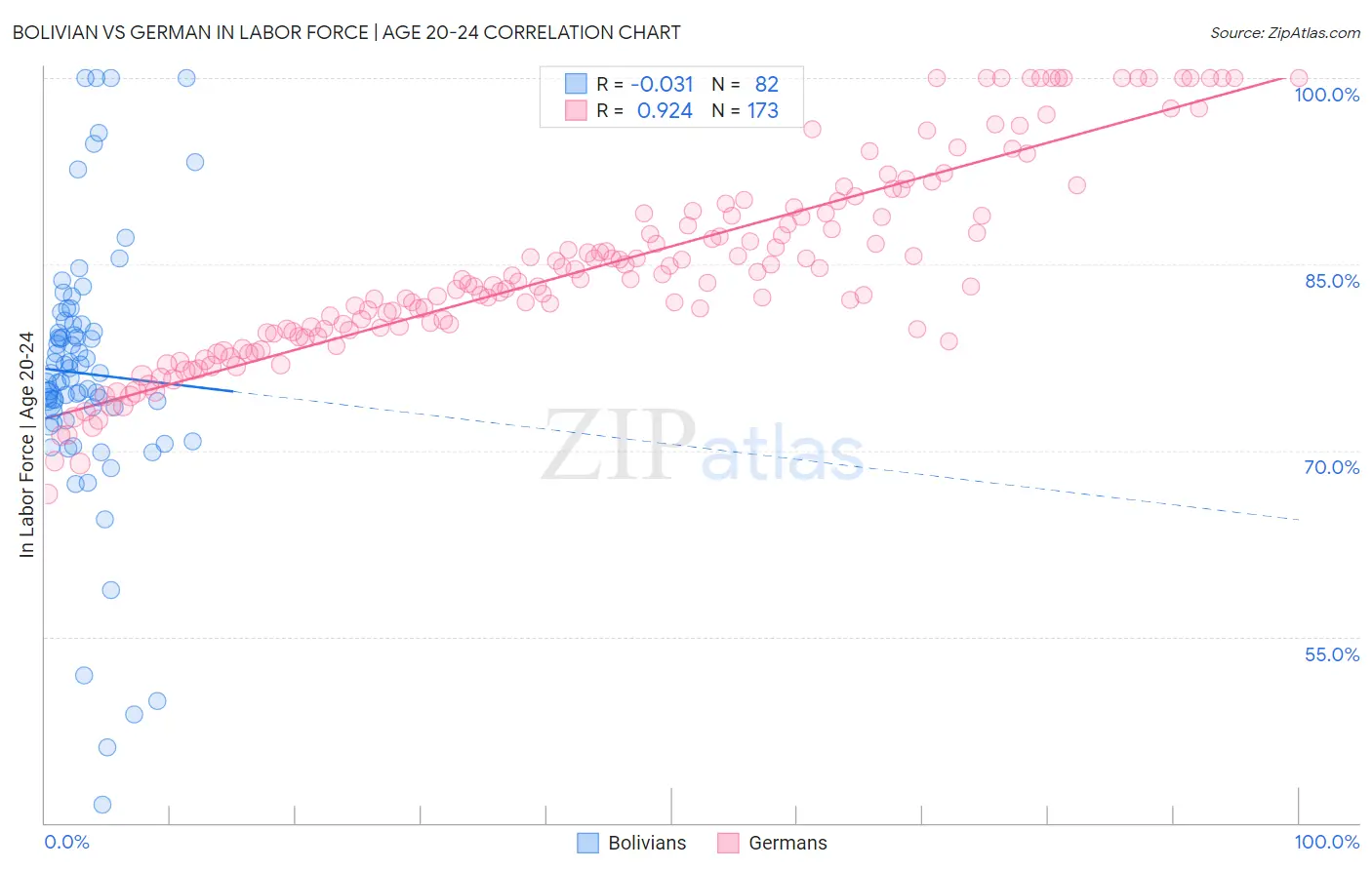Bolivian vs German In Labor Force | Age 20-24
COMPARE
Bolivian
German
In Labor Force | Age 20-24
In Labor Force | Age 20-24 Comparison
Bolivians
Germans
75.2%
IN LABOR FORCE | AGE 20-24
64.0/ 100
METRIC RATING
164th/ 347
METRIC RANK
78.6%
IN LABOR FORCE | AGE 20-24
100.0/ 100
METRIC RATING
12th/ 347
METRIC RANK
Bolivian vs German In Labor Force | Age 20-24 Correlation Chart
The statistical analysis conducted on geographies consisting of 184,640,260 people shows no correlation between the proportion of Bolivians and labor force participation rate among population between the ages 20 and 24 in the United States with a correlation coefficient (R) of -0.031 and weighted average of 75.2%. Similarly, the statistical analysis conducted on geographies consisting of 578,744,060 people shows a near-perfect positive correlation between the proportion of Germans and labor force participation rate among population between the ages 20 and 24 in the United States with a correlation coefficient (R) of 0.924 and weighted average of 78.6%, a difference of 4.5%.

In Labor Force | Age 20-24 Correlation Summary
| Measurement | Bolivian | German |
| Minimum | 41.5% | 66.5% |
| Maximum | 100.0% | 100.0% |
| Range | 58.5% | 33.5% |
| Mean | 76.2% | 84.7% |
| Median | 76.0% | 83.6% |
| Interquartile 25% (IQ1) | 73.2% | 79.5% |
| Interquartile 75% (IQ3) | 80.2% | 89.1% |
| Interquartile Range (IQR) | 6.9% | 9.6% |
| Standard Deviation (Sample) | 10.8% | 7.8% |
| Standard Deviation (Population) | 10.7% | 7.8% |
Similar Demographics by In Labor Force | Age 20-24
Demographics Similar to Bolivians by In Labor Force | Age 20-24
In terms of in labor force | age 20-24, the demographic groups most similar to Bolivians are Costa Rican (75.2%, a difference of 0.0%), Immigrants from Romania (75.2%, a difference of 0.010%), Afghan (75.2%, a difference of 0.010%), New Zealander (75.2%, a difference of 0.020%), and Cambodian (75.2%, a difference of 0.050%).
| Demographics | Rating | Rank | In Labor Force | Age 20-24 |
| Immigrants | Western Europe | 71.5 /100 | #157 | Good 75.3% |
| Immigrants | Bolivia | 71.0 /100 | #158 | Good 75.3% |
| South American Indians | 69.0 /100 | #159 | Good 75.3% |
| Japanese | 68.7 /100 | #160 | Good 75.3% |
| New Zealanders | 65.4 /100 | #161 | Good 75.2% |
| Immigrants | Romania | 64.6 /100 | #162 | Good 75.2% |
| Costa Ricans | 64.2 /100 | #163 | Good 75.2% |
| Bolivians | 64.0 /100 | #164 | Good 75.2% |
| Afghans | 63.5 /100 | #165 | Good 75.2% |
| Cambodians | 60.5 /100 | #166 | Good 75.2% |
| Immigrants | South Eastern Asia | 57.5 /100 | #167 | Average 75.1% |
| Immigrants | Western Africa | 56.7 /100 | #168 | Average 75.1% |
| Immigrants | Philippines | 55.8 /100 | #169 | Average 75.1% |
| Mexicans | 52.1 /100 | #170 | Average 75.1% |
| Cajuns | 51.1 /100 | #171 | Average 75.1% |
Demographics Similar to Germans by In Labor Force | Age 20-24
In terms of in labor force | age 20-24, the demographic groups most similar to Germans are Scandinavian (78.5%, a difference of 0.070%), Czech (78.5%, a difference of 0.070%), Finnish (78.7%, a difference of 0.11%), Slovene (78.7%, a difference of 0.15%), and Sudanese (78.4%, a difference of 0.21%).
| Demographics | Rating | Rank | In Labor Force | Age 20-24 |
| Aleuts | 100.0 /100 | #5 | Exceptional 79.0% |
| Danes | 100.0 /100 | #6 | Exceptional 79.0% |
| Luxembourgers | 100.0 /100 | #7 | Exceptional 79.0% |
| Immigrants | Cabo Verde | 100.0 /100 | #8 | Exceptional 78.9% |
| Swedes | 100.0 /100 | #9 | Exceptional 78.8% |
| Slovenes | 100.0 /100 | #10 | Exceptional 78.7% |
| Finns | 100.0 /100 | #11 | Exceptional 78.7% |
| Germans | 100.0 /100 | #12 | Exceptional 78.6% |
| Scandinavians | 100.0 /100 | #13 | Exceptional 78.5% |
| Czechs | 100.0 /100 | #14 | Exceptional 78.5% |
| Sudanese | 100.0 /100 | #15 | Exceptional 78.4% |
| Dutch | 100.0 /100 | #16 | Exceptional 78.4% |
| Cape Verdeans | 100.0 /100 | #17 | Exceptional 78.3% |
| Immigrants | Bosnia and Herzegovina | 100.0 /100 | #18 | Exceptional 78.1% |
| Bangladeshis | 100.0 /100 | #19 | Exceptional 78.1% |